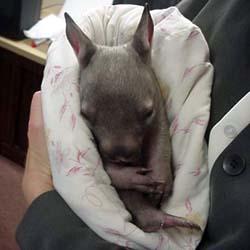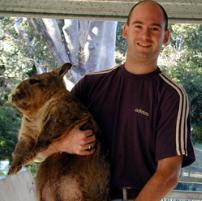Baby wombat scheduled to make a public appearance
Published on 13 September, 2002
Allenstown State School Year One students are expected to meet a baby wombat next week at the Central Queensland Wombat Research Centre.
The children were winners of the Central Queensland University Office of Research’s design-a-poster competition. As part of their prize the children were invited to visit the Research Centre to see all 17 wombats, especially Kooloola, a nine month-old southern hairy-nosed wombat. Kooloola, was named after the property she was found on in South Australia. Kooloola arrived at the Centre at the tender age of 3.6-months-old, weighing just 224 grams. She was pink, furless and her eyes were still sealed. Today she weighs in at a little over 4kg and is almost 58cm long with a beautiful silky deep grey coat. Kooloola is cared for by wildlife carer Annie Saunders, who has nurtured the baby wombat in a home environment since her arrival in Rockhampton.
 “She sleeps most of the day and only wakes for feeds (three per day) and a wander around in the early morning and late afternoon or evening,” Ms Saunders said.
“She sleeps most of the day and only wakes for feeds (three per day) and a wander around in the early morning and late afternoon or evening,” Ms Saunders said.
“She’s like a small puppy following us around and playing.” Postgraduate research candidate at CQU, Glenn Druery, is researching the reproduction of the southern hairy-nosed wombat at the Rockhampton-based Research Centre. He is currently in South Australia researching super-ovulation techniques that could be practised in Central Queensland.
The Research Centre’s Dr Alan Horsup said it is the breeding season in South Australia at the moment, which has helped Glen’s research by providing a larger sample size.
Dr Horsup said the research to date had been rewarding and he was particularly pleased with the health of Kooloola.
The Wombat Research Centre has been designed to help save the northern hairy-nosed wombat. The northern species is one of the world’s most endangered mammals with only 110 surviving on one small national park in Central Queensland.
 Because the southern hairy-nosed wombats are closely related to the northern variety, they are currently being used at the Research Centre in an effort to develop assisted reproductive techniques for the endangered northern hairy-nosed wombat.
Because the southern hairy-nosed wombats are closely related to the northern variety, they are currently being used at the Research Centre in an effort to develop assisted reproductive techniques for the endangered northern hairy-nosed wombat.
Mr Druery is a clinical embryologist at Rockhampton’s IVF Clinic, Central Queensland Fertility (CQF). He has used his knowledge and experience from the clinic in his research of wombats. CQF is the industry-based partner in a unique relationship between CQU, and local and state governments (Rockhampton City Council and Queensland Parks and Wildlife Service), which drives the Research Centre.
Left: Baby Kooloola (Lulu).
Above: Wombat researcher Glen Druery and Winnie.

